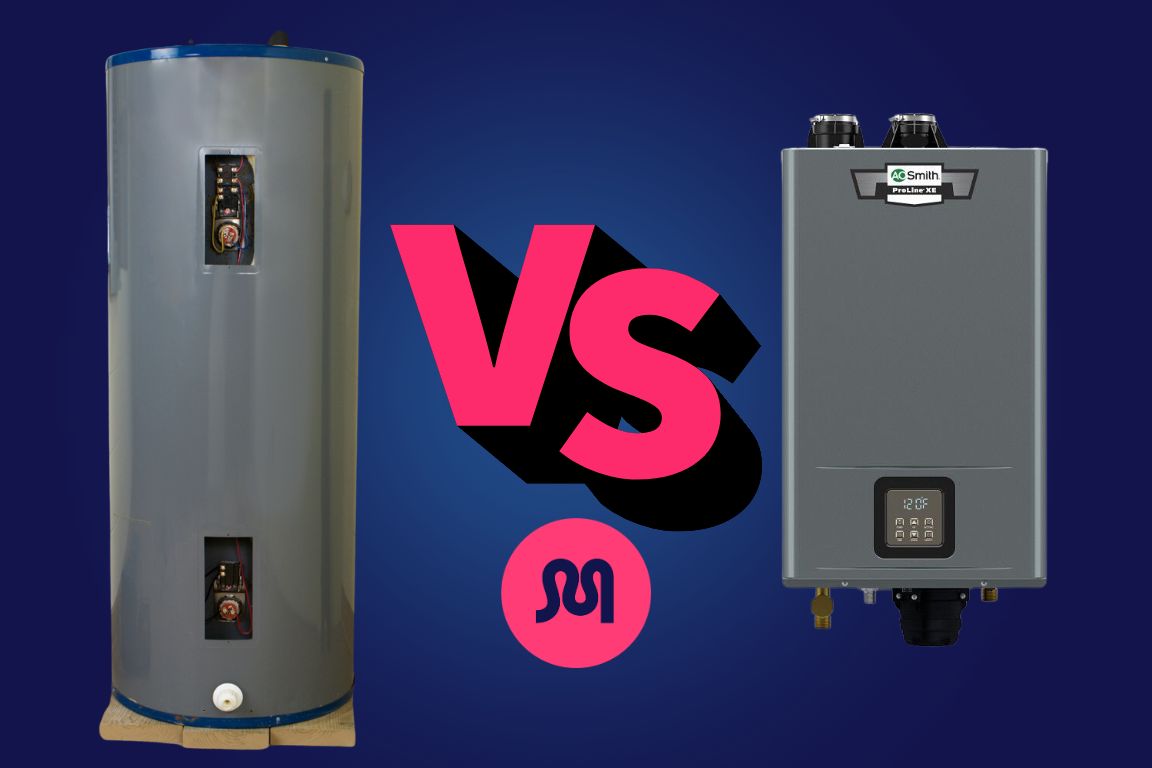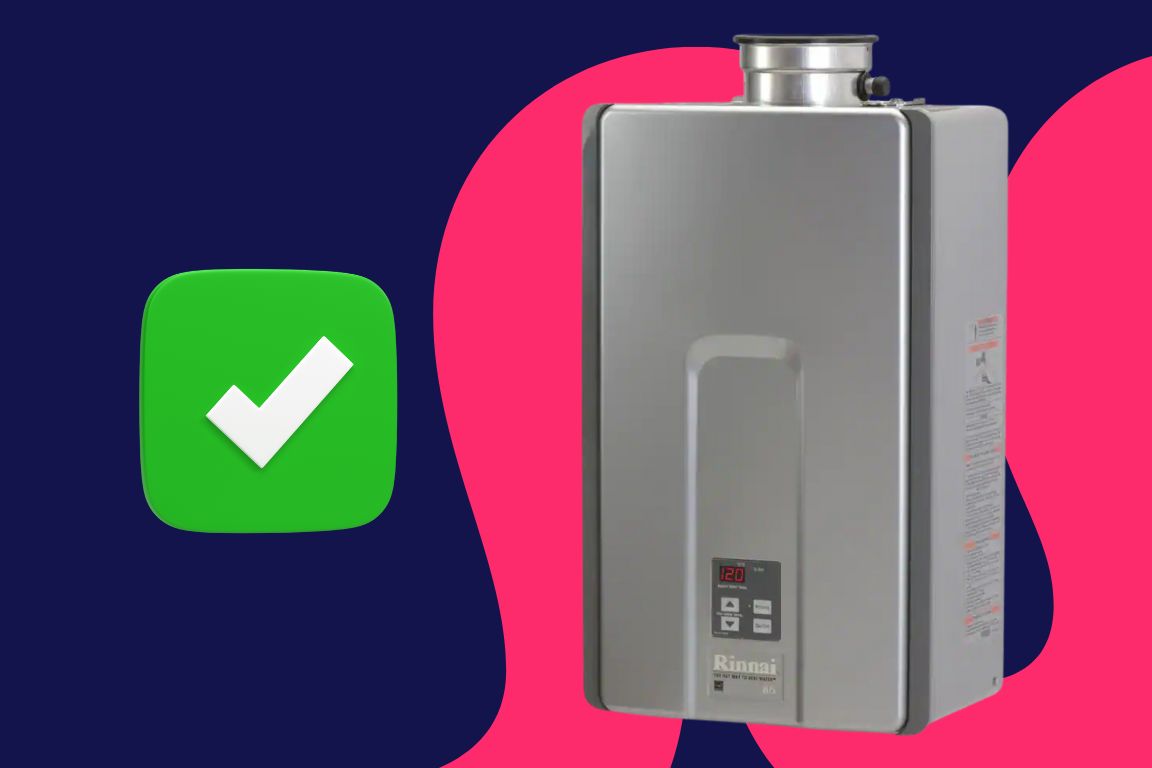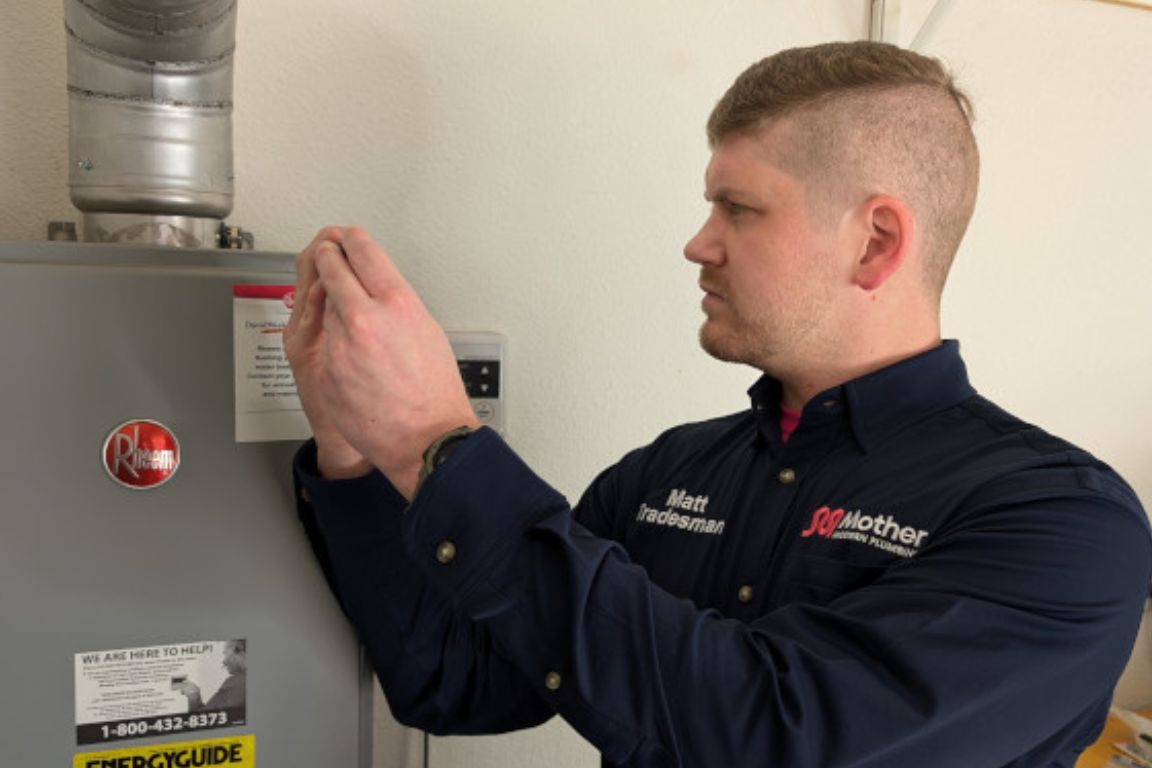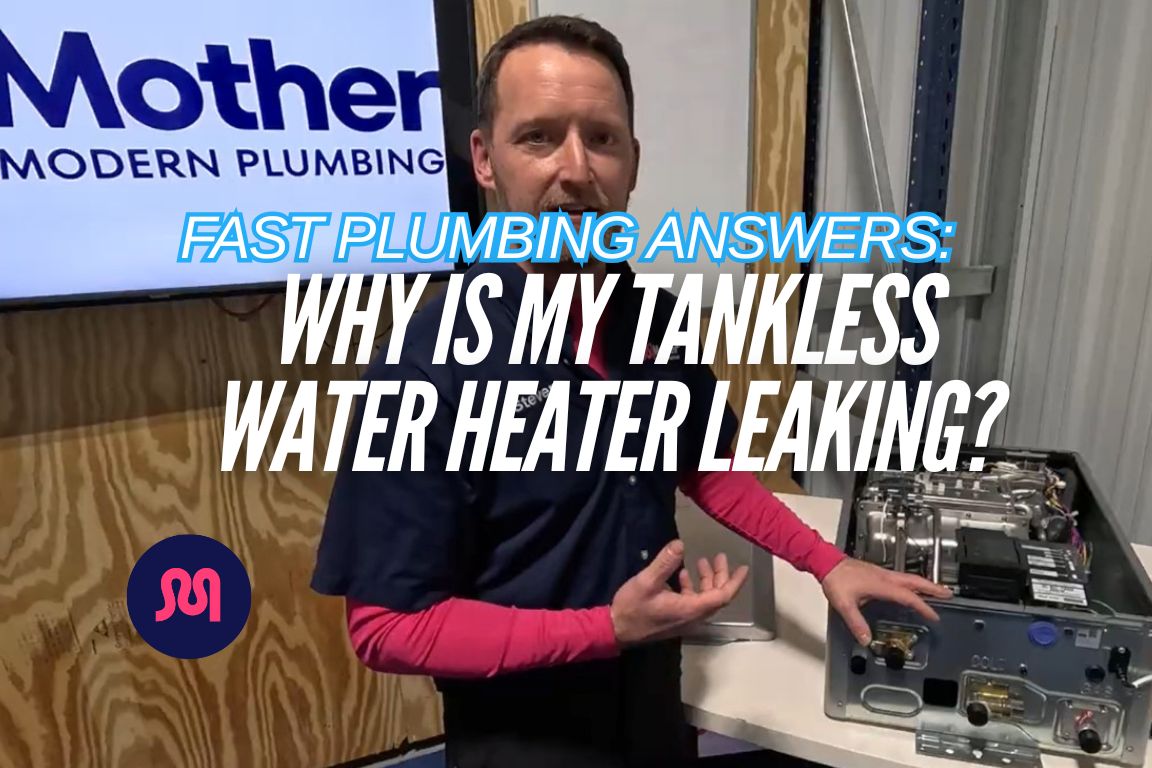Should You Switch to Tankless or Keep Your Water Heater?

table of contents
table of contents
We updated this guide with information about potential insurance benefits of switching to tankless water heaters in natural gas homes- including where to put your new tankless for better insurance coverage. We also updated our homeowner profiles to reflect types of consumers who benefit most from a switch to tankless.
Switching from a conventional water heater to a tankless unit isn’t right for everyone. Yes, the idea of lower energy bills and on-demand hot water is appealing- and so is saving some precious square footage in your garage. But for some homeowners, the cost of installation and upgrading your electrical panel means you’ll never make that money back.
In this article, our plumbing experts outline the three types of homeowners who benefit the most from replacing their water heater with a tankless. We’ll also explain why tankless systems are virtually never a good idea for electric-powered homes.
At Mother, our expert plumbers give homeowners real-world answers to questions about evolving technology- like replacing your water heater with a tankless. Our team regularly researches, installs and repairs products from A.O. Smith, Rheem, Rinnai, and Navien.
Dallas: ready to go tankless? Call Mother 24/7 for expert installation service- skip the line and claim the first available appointment!
{{tankless-water-heater-installation="/services/tankless-water-heater-installation"}}
Traditional Water Heater vs. Tankless: Pros and Cons

Don’t have time to read the full article? Let’s give you a quick overview by making some direct comparisons between conventional water heaters and tankless units.
What’s the overall cost to purchase, install and maintain them? How do they deliver hot water? What common issues arise, and what maintenance is necessary? And how do common warranty offers compare?
Direct Comparisons: Traditional Water Heaters vs. Tankless Water Heaters
When to Go Tankless vs. When to Keep Your Tank

Now that you’re armed with the pros and cons of tankless water heaters compared to conventional systems, let’s get down to brass tacks- is switching to tankless the right idea for your specific home?
Let’s examine 7 common scenarios and tell you if “going tankless” is a good or bad idea.
2 Times You Should Keep Your Tank
Our plumbers advise homeowners in these situations to avoid the switch to tankless.
- Electric-powered homes should never install a tankless .Our Responsible Master Plumber Steven Smith says the cost of switching to an electric tankless water heater is “rarely” worth it. “Typically you have to get a whole new subpanel installed in order to have an electric tankless be worth anything to you,” Steven says.
- You have a small home. Homes with less than 2 bathrooms should stick with the tank. The low hot water demand means the energy savings from tankless will rarely pay back the higher installation cost. In this case, tanks are more economical. (The exception to this rule is to save space: more on this later.)
{{are-electric-tankless-water-heaters-good="/blogs/are-electric-tankless-water-heaters-good"}}
5 Times Switching to Tankless is a Great Idea
These are the 5 situations where converting to a tankless water heater makes the most sense.
- You use natural gas or propane. High-BTU natural gas allows the tankless unit to heat water rapidly and efficiently to meet flow rate demands. The infrastructure upgrades needed to switch are far less than for electric units.
- You have a large home. Working with 3,000 square feet and 4+ baths? This is the ideal scenario for a tankless unit. High demand from multiple showers, tubs, and appliances running simultaneously benefits from the continuous delivery capacity of a tankless system.
- Your home is 50+ years old. These homes often have small utility closets or basement spaces where reclaiming square footage is a huge win. You’ll likely need to invest in a venting upgrade- but aging homes benefit from those anyway.
- You’re doing a brand new home build. Save space in the initial design, ensure you meet current energy codes, and start with continuous hot water delivery from day one.
- Your energy provider offers a great rebate. $1,000 rebates from Con Edison in New York, SmartChoice programs from Atmos Energy in Texas, $600 Energy Star rebates- there are plenty of financial incentives to choose gas tankless water heaters.
Based on our Master Plumbers’ advice, assume all suggestions to convert to a tankless water heater are for gas systems only.
{{are-gas-tankless-water-heaters-good="/blogs/are-gas-tankless-water-heaters-good"}}
Tank or Tankless? Comparing Specific User Scenarios
Let’s look at specific homeowner scenarios and gauge whether a traditional water heater or tankless system is best for their needs.
3 Types of Homes That Benefit from Tankless Water Heaters
Here are three profiles of homeowners who found the tankless switch to be the perfect solution for their specific needs.
The High-Demand Family
If you’re a family with 2+ kids (or grandma living at home), you know all about running out of hot water on the third shower in a row- or a burst of cold water when you try to shower while the dishwasher’s running.
Gas-powered households solve this problem by installing high-capacity tankless systems that provide continuous flow. These homeowners care less about upfront cost and more about long-term savings.
Utility/Energy Savings: Minimal. The energy savings are offset by the high volume of water used. Their ROI is based on longevity (20+ years) and convenience, not monthly savings.
Maintenance: Required Annual Descaling. They accept paying a plumber for a yearly service to ensure the heat exchanger remains clear of mineral buildup.
The Down-Sizing Retirees
Moving into a smaller home or a 55+ community? You need space for all the stuff that used to fit in your attic or garage- and the footprint of a water heater tank doesn’t make sense.
Save space in that cramped utility closet with a gas tankless system. (Imagine how much nicer a stackable washer and dryer would look in there instead!) A tankless unit makes a ton of sense for empty nest couples with smaller laundry needs and one shower per day.
Utility/Energy Savings: Maximum Potential. Because their total usage is low, they see the largest percentage decrease in energy usage since the system is dormant most of the day (no standby loss).
Maintenance: Below Average. Due to low usage, the annual flush may be shifted to every 18 months, but they strictly adhere to the schedule to preserve the unit's high efficiency and warranty.
The Hard Water Sufferers
You’ve replaced two traditional water heaters in the last 15 years due to corrosion, sediment buildup and mineral scaling that ruined your T&P valve. While you still need to descale a tankless system, the cost of maintenance sure beats spending $2,000 on a new tank every 8 years.
If you’re diligent about scheduling preventative maintenance, gas tankless systems are a great option for growing families in hard water regions like North Texas. We regularly install tankless water heaters in Plano and fast-growing cities like Flower Mound. This allows their residents to grow into their homes while mitigating hard water concerns.
Utility/Energy Savings: Moderate. For them, the real savings is avoiding the $2,000 cost of a new tank installation every 7-8 years.
Maintenance: Annual Flush and Descaling. This homeowner views the annual maintenance fee not as a cost, but as insurance against premature failure. It’s the best way to manage their local hard water quality.
Pro Tip! Put your tankless water heater on the first floor to have the best chance at insurance perks and premium reductions- carriers prefer it.
Tankless Water Heaters: Myths vs. Facts

Most homeowners decide to switch to tankless systems based on what they’ve heard from friends or read online. Their interest is based on 3 primary goals:
- A desire for less water heater maintenance;
- Instant, on-demand hot water 24/7;
- A smart investment that saves you money long-term.
But how true are these beliefs? Let’s separate fact from fiction and help you make an informed purchasing decision.
Myth: Tankless water heaters give you instant, on-demand hot water.
Reality: This is half-true. On-demand hot water yes… but not “instant”.
Tankless water heaters are designed to provide on-demand hot water in a continuous flow, instead of the finite amount of water stored in a tank system. This eliminates the “standby loss” of keeping 50-75 gallons hot 24/7.
While your water does heat up fast, it’s not instantaneous. You’ll need to wait a few seconds- especially to avoid the “cold water sandwich” of pre-existing water in your lines from the last time you used hot water.
Myth: Tankless water heaters don’t need maintenance.
Reality: Tankless systems need just as much maintenance as tanks.
Contrary to popular belief, a tankless unit is just as sensitive to hard water as a tank water heater. Getting rid of your tank doesn’t eliminate the calcium and magnesium from your incoming water supply- it just changes the components of your water heater that are affected.
Instead of scaling and corrosion within your tank, you’ll experience mineral buildup in your tankless inlet filter and heat exchanger.
The true advantage tankless units have in terms of hard water comes with regular maintenance. Tanks fail over time via corrosion and sediment buildup, leading to leaks and replacement in 8-12 years.
Tankless units are designed to be flushed and maintained annually. As long as you descale the unit every year, the tankless heat exchanger is superior to the tank in the long run. A properly maintained tankless lasts 20+ years- twice as long as the average tank.
Myth: You’ll save money with a tankless.
Reality: Some aspects of tankless ownership cost less, and some cost more.
Let’s address this belief point-by-point.
Tankless systems are absolutely more energy efficient than tanks, especially if you only use a modest amount of water. The Department of Energy estimates 34% energy savings for homes using 41 gallons or less per day.
However, this energy efficiency doesn’t automatically mean financial savings. Actual savings on utility bills depend entirely on your home water usage habits. If you’re a single homeowner, your modest water demand won’t justify the high upfront cost of switching by itself.
The real savings of a tankless come in two ways:
1. System longevity. Maintain and descale it properly, and you’ll enjoy a 20+ year lifespan. Compare this with the average lifespan of a water heater tank (8-12 years). Live in your home for 50 years, and you’ll only buy 2 tankless water heaters- compared to 5 tanks.
2. Insurance perks. “[Carriers] don’t want a tank,” says Paxten Volbrecht, Director of Agency Operations for Jacobs Insurance Solutions. “If a tank is going to burst, that is a lot of water coming out at one period of tank versus a tankless. Preferred customers are going to be ones that have… tankless heaters.”
Check if your insurance provider offers incentives for switching to a tankless system. These are more likely to be premium discounts- we don’t see many installation rebates.
{{dallas-tankless-water-heaters-save-money="/blogs/dallas-tankless-water-heaters-save-money"}}
The True Cost of Going Tankless: Infrastructure Upgrades Homeowners Miss
When you get an initial quote for a tankless water heater, the unit itself is only half the story. Unlike the “one-for-one swap” of installing another tank, a tankless unit is a major appliance that often requires an upgrade to your home's gas, venting, or electrical infrastructure.
Homeowners who don’t know these upgrades are coming often experience “sticker shock” when they see their installation quote.
Use our insights to approach these infrastructure costs, and you’ll make smart decisions that pay themselves back in energy savings and increased lifespan.
1. Gas Line Resizing: The Non-Negotiable Cost
Gas tankless heaters are extremely powerful, requiring lots of fuel to heat water instantly. Your existing tank heater only needs 30,000 to 40,000 BTUs, because it only heats a finite amount of water.
Install a tankless, and you’ll need 5x as much power to operate the system.
- The Issue: The gas line currently feeding your old tank is almost certainly too small to handle the new demand. Attempting to use the old line will cause the tankless unit to starve for fuel, leading to inconsistent temperatures and premature failure.
- The Cost: This requires the plumber to install a new, dedicated, and significantly wider gas line running from your home's main meter directly to the tankless unit. This is a complex, labor-intensive job involving materials and gas code compliance, and it's mandatory for a proper installation.
2. Venting and Exhaust: The Code Requirement
Conventional gas tanks vent exhaust using a simple flue pipe that relies on natural draft, often venting through a chimney. Tankless units cannot use this old system.
- The Issue: Modern, high-efficiency tankless heaters are forced-draft appliances that require specialized venting to expel combustion gases. This usually means installing Category III stainless steel venting (or thick PVC pipe for condensing models) that must run horizontally through a side wall or vertically through the roof.
- The Cost: If your current water heater is deep inside a closet or basement, running this new, rigid exhaust pipe can be challenging and expensive. This cost includes both the specialized materials and the labor to cut and seal the new exterior exit point.
3. Electric Homes: A Non-Starter for Most
If you live in a home without natural gas and are considering an electric tankless unit, the cost of electrical work is enough to turn most homeowners off for good.
- The Issue: To provide continuous, high-flow hot water, electric tankless units demand an astonishing amount of power, often requiring 150 to 200 amps of dedicated circuit capacity. Most homes simply do not have that much power available on their current electrical service panel.
- The Cost: The only solution is an electrical service panel upgrade, which involves coordinating with an electrician and potentially your utility company. This can easily be the most expensive component of the entire project and must be weighed carefully against the benefit.
4. The Cost of Improper Sizing (GPM Failure)
The final mistake homeowners make is buying an under-sized unit to save money. While your upfront cost goes down, the tankless unit won’t properly serve your home- and you’ll end up paying twice to replace the system.
- Sizing is Everything: Tankless units are sized based on Gallons Per Minute (GPM), which is the amount of hot water the unit can deliver at peak use. A large home (4+ baths) needs a minimum of 9.5 GPM capacity.
- The Failure: If you install an 8 GPM unit in a home that frequently runs two showers and a dishwasher at the same time, the unit will not keep up. Instead of hot water, you’ll get lukewarm water or a constantly fluctuating temperature, rendering the investment useless for your lifestyle.
- The Cost: The cost of this error is the wasted time and money on a unit that doesn't meet your needs- and the money you’ll spend installing a new one.
Learn how to size your tankless in our updated quick guide!
{{fast-plumbing-answers-how-to-size-a-tankless-water-heater="/blogs/fast-plumbing-answers-how-to-size-a-tankless-water-heater"}}
Replacing Water Heater With Tankless? Call Mother

Switching to a tankless water heater is a great decision for homeowners who meet three major criteria:
- Your home runs on natural gas;
- You have above average daily water demands;
- You live in an area plagued by hard water issues.
Homeowners with existing electrical systems and smaller houses will find the initial cost of tankless installation too high to be offset by future energy savings..
If you’re willing to commit to annual descaling and maintenance, your new tankless unit will easily thrive for 20+ years- you’d buy 2-3 conventional tanks in the same span of time.
Dallas: ready to go tankless? Call Mother 24/7 for expert installation service- our plumbing experts offer the single best solution for your home.
{{tankless-water-heater-installation="/services/tankless-water-heater-installation"}}
Common Q’s about Water Heaters
Are tankless water heaters more efficient than tank water heaters?
Yes, the U.S. Department of Energy reports that tankless water heaters are up to 34% more efficient than tank water heaters. That's because tankless heaters don’t store water. Instead, they heat water on demand and only when needed.
Can I get a tax credit for a tankless water heater?
Yes, natural gas tankless water heaters installed between 2023 and 2032 are eligible for the EnergyStar Energy Efficient Home Improvement Tax Credit. It covers 30% of the total installation cost up to $600. ENERGY STAR rated tankless water heater models with ≥ 0.95 UEF are eligible.
Do tankless water heaters lower your home insurance?
Tankless water heaters can reduce insurance premiums due to the reduced risk of not having a full tank in your home. Ask your insurance agent if any premium discounts apply to new water heater installation.
What are the most common tankless water heater repair types?
A majority of tankless water heater repairs (especially in DFW) involve one of these six key issues:
- Descaling due to mineral buildup
- Ignition system issues (blocked sensors)
- Blockages of vents
- Faulty flow sensors
- Leaks from a damaged heat exchanger or valves
- Damaged gas flexes and closed valves (gas units)
How often should I descale my tankless water heater?
Perform tankless water heater descaling once every 6-12 months in most areas to eliminate mineral buildup in the system.
If you live in areas with extremely hard water- such as Dallas-Fort Worth- consider decaling your on-demand hot water heater every 6-8 months (roughly twice a year). Limescale is particularly hard on tankless units in our area.




